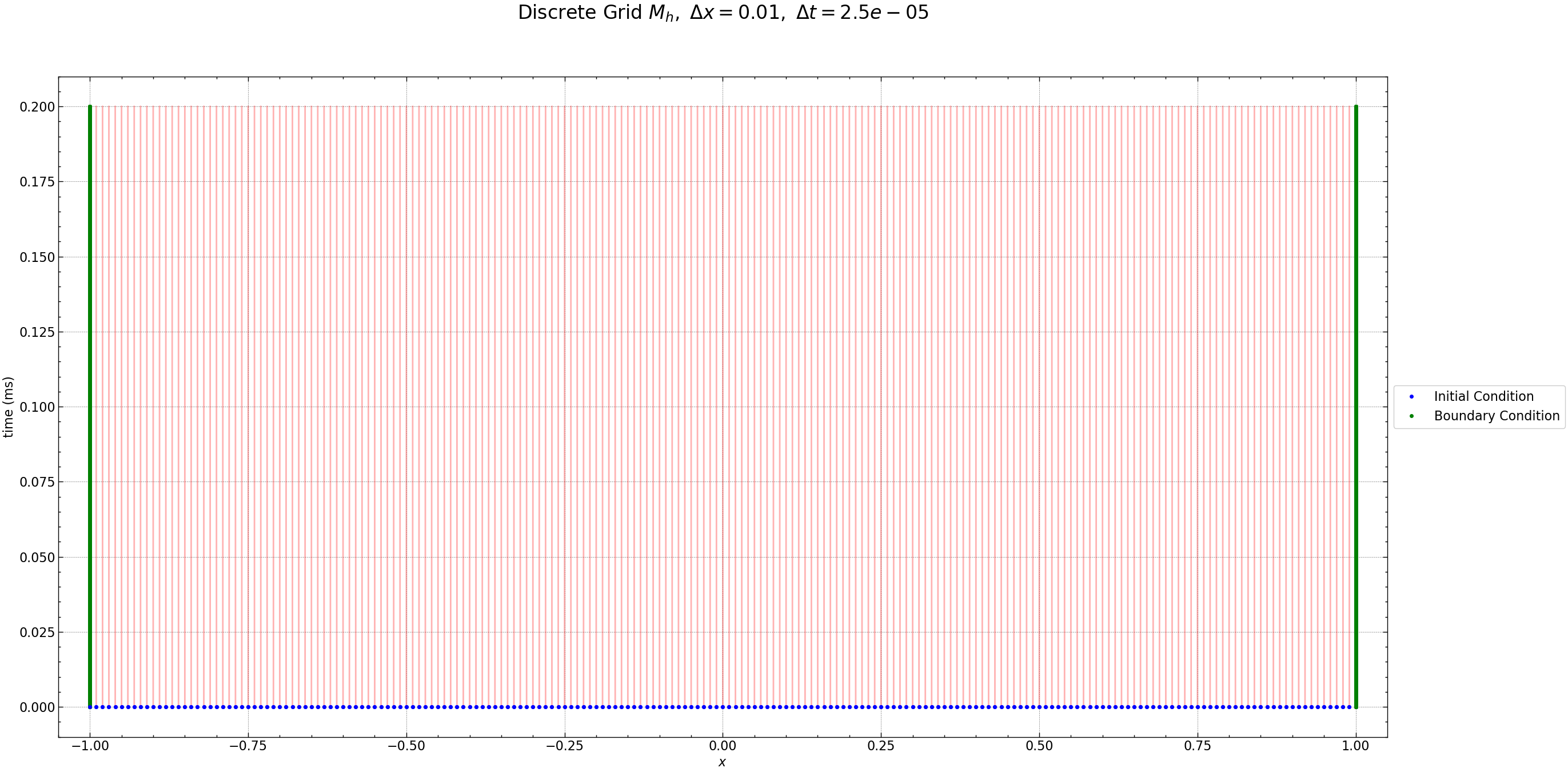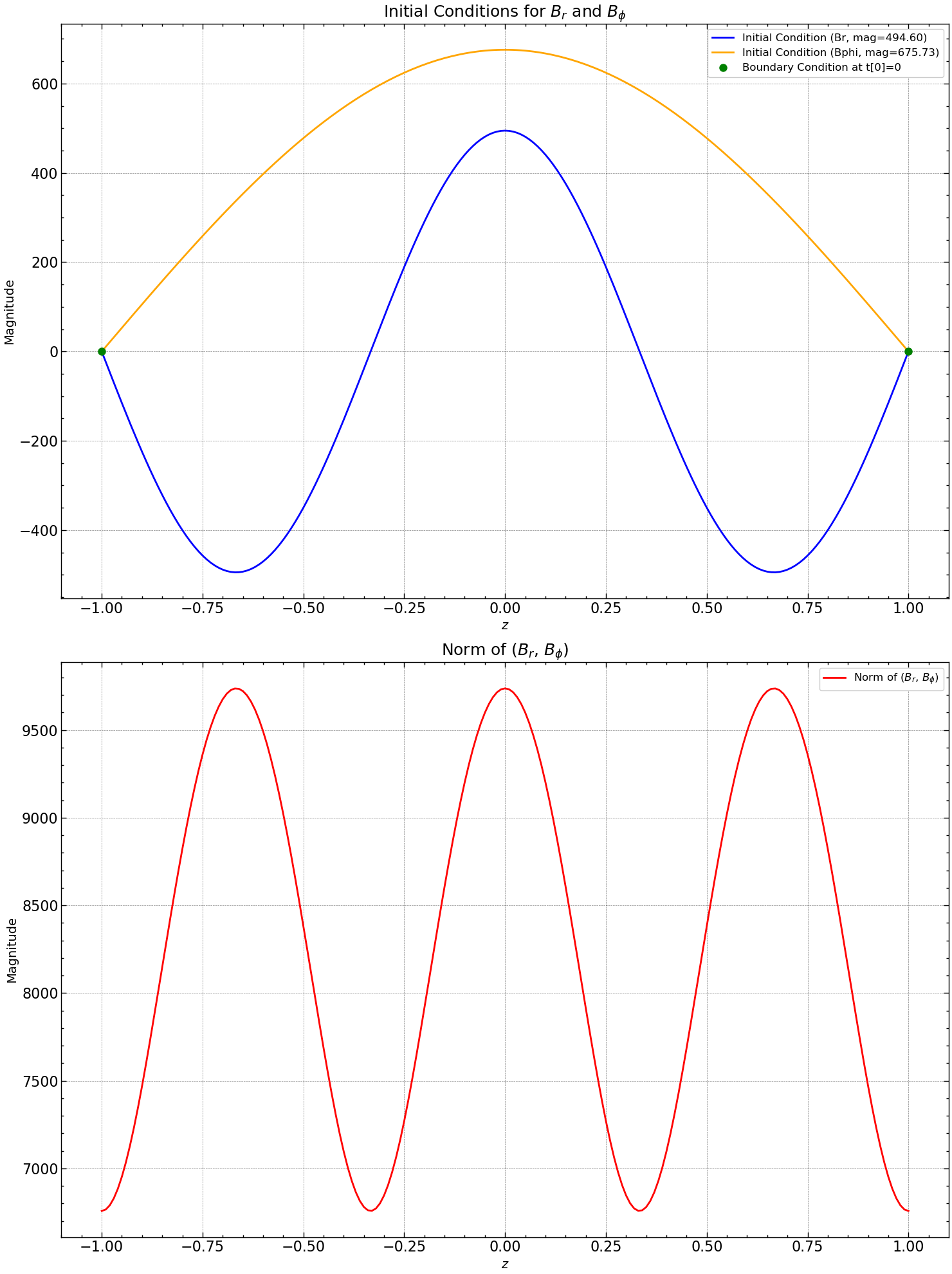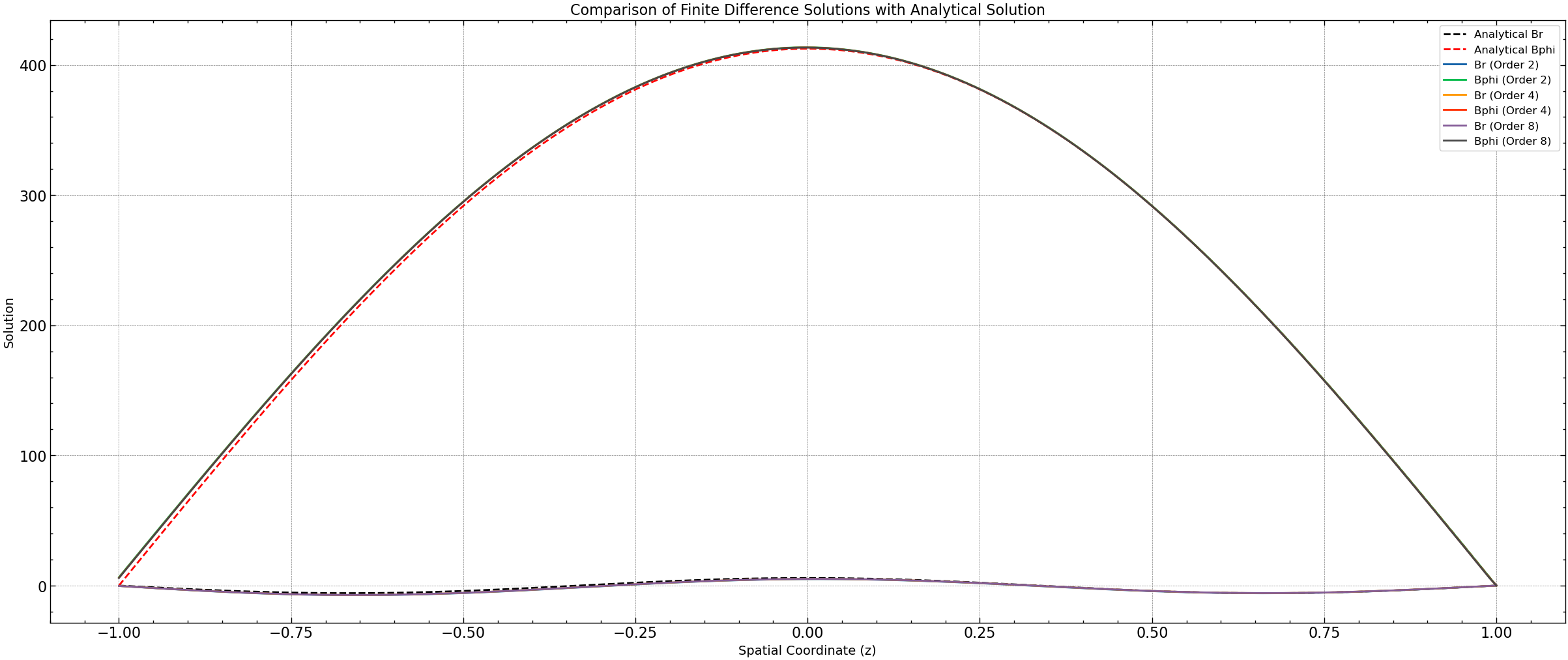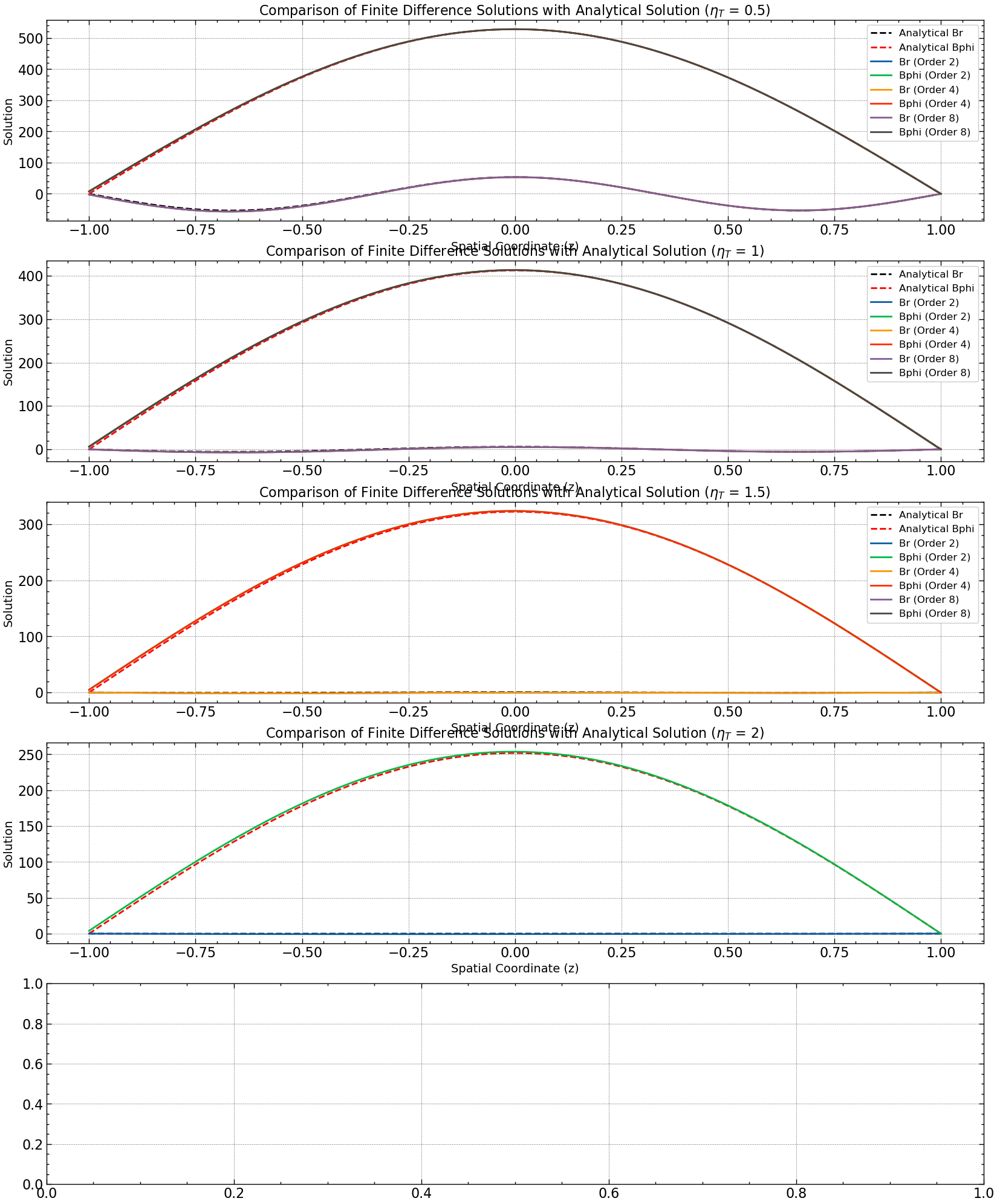%load_ext notexbook
%texify -v
2.0.1).
Theme Settings:
- Notebook: Computer Modern font; 16px; Line spread 1.4.
- Code Editor:
Fira Codefont;14px; Material Theme. - Markdown Editor:
Hackfont;14px; Material Theme.
Sensetivity Analysis of Magnetic Diffusion Equation#
The Galactic Dynamo Diffusion Equation describes the evolution of the magnetic field components \( \bar{B}_r \) and \( \bar{B}_\phi \) in the galaxy over time. It is given by two coupled partial differential equations:
Radial Magnetic Field Equation: $\( \frac{\partial \bar{B}_r}{\partial t} = \eta_t\frac{\partial^2 \bar{B}_r}{\partial z^2} \)$ This equation describes how the radial component of the magnetic field changes with time due to diffusion.
Azimuthal Magnetic Field Equation: $\( \frac{\partial \bar{B}_\phi}{\partial t} = \eta_t \frac{\partial^2 \bar{B}_\phi}{\partial z^2} \)$ Similarly, this equation describes how the azimuthal component of the magnetic field changes with time due to diffusion.
Here, \( \eta_T \) is the magnetic diffusivity, which is assumed to be constant.
import numpy as np
from tabulate import tabulate
from PIL import Image
import matplotlib.pyplot as plt
import scienceplots
plt.style.use(['science', 'notebook', 'grid'])
from matplotlib.animation import FuncAnimation
from IPython import display
import time as timeit
from matplotlib import rcParams
rcParams['axes.grid'] = True
rcParams['grid.linestyle'] = '--'
rcParams['grid.alpha'] = 0.5
%matplotlib inline
import warnings
warnings.filterwarnings("ignore")
N = 200
Nt = 40000
h = 2 / N
k = 1 / Nt
r = k / (h * h)
eta_t = 1 # diffusion coefficient
time_steps = 8000
time = np.arange(0, (time_steps + 0.5) * k, k)
z = np.arange(-1.00, 1.0001, h)
Z, Y = np.meshgrid(z, time)
CFL Condition in Finite Difference Methods#
To solve the diffusion equation numerically, we discretize both time and space using finite differences. A common approximation for the second derivative with respect to space is:
Where \(u_i\) represents the value of \(u\) at the \(i\) th spatial grid point, and \(\Delta x\) is the spatial grid spacing. To ensure stability and accuracy in the numerical solution, it’s essential to choose an appropriate time step $\Delta t. The CFL condition emerges from the requirement that changes in the solution over time must be adequately resolved by the spatial discretization.
The CFL Condition:#
For explicit time integration schemes applied to diffusion problems, the CFL condition is typically expressed as:
The numerator, \( \Delta t \), represents the time step.
The denominator, \( 2 \cdot (\Delta x)^2 \), represents the spatial resolution scaled by a factor of 2.
In particular, for diffusion problems, the time evolution of the solution is controlled by the diffusivity term, typically denoted by ( \alpha ) or ( D ). This condition ensures that the time step is chosen small enough so that changes in the solution over time do not propagate too quickly relative to the spatial discretization. Thus, when implementing explicit time-stepping schemes for diffusion problems using FDM, adhering to the CFL condition helps prevent numerical instabilities. By keeping the CFL number (the ratio \( \frac{\alpha \Delta t}{2 \cdot (\Delta x)^2} \)) below 0.5, the time integration scheme remains stable and capable of accurately capturing the diffusion process.
fig = plt.figure(figsize=(30, 15))
plt.plot(Z, Y, 'r-', alpha=0.3)
plt.plot(z, 0 * z, 'bo', markersize=4, label='Initial Condition')
plt.plot(np.ones(time_steps + 1) * -1, time, 'go', markersize=4, label='Boundary Condition')
plt.plot(z, 0 * z, 'bo', markersize=4)
plt.plot(np.ones(time_steps + 1) * 1, time, 'go', markersize=4)
plt.xlim((-1.05, 1.05))
plt.xlabel(r'$x$')
plt.ylabel(r'time (ms)')
plt.legend(loc='center left', bbox_to_anchor=(1, 0.5))
plt.title(r'Discrete Grid $M_h,$ $\Delta x= %s,$ $\Delta t=%s$' % (h, k), fontsize=24, y=1.08)
plt.grid(True, linestyle='--', alpha=0.5)
plt.show()

Analytical Solution
def generate_random_Bo(seed_value):
np.random.seed(seed_value)
random_float = np.random.rand()
return random_float
def initial_conditions(N, time_steps, seed_value, m, n, BCtype = "vacuum"):
mag_br = 1000*generate_random_Bo(seed_value)
mag_bphi = 1000*generate_random_Bo(seed_value + 1)
z = np.linspace(-1, 1, N+1)
Br = np.zeros((N+1, time_steps+1))
Bphi = np.zeros((N+1, time_steps+1))
b1 = np.zeros(N-1)
b2 = np.zeros(N-1)
# Initial Condition for Br and Bphi
for i in range(1, N+1):
Br[i, 0] = mag_br * np.cos((m + 1/2) * np.pi * z[i])
Bphi[i, 0] = mag_bphi * np.cos((n + 1/2)* np.pi * z[i])
# Boundary Condition
if BCtype == "vacuum":
Br[0, :] = 0
Bphi[0, :] = 0
Br[N, :] = 0
Bphi[N, :] = 0
return z, Br, Bphi, b1, b2, mag_br, mag_bphi
seed_value = 50
m, n = 1, 0
z, Br, Bphi, b1, b2, mag_br, mag_bphi = initial_conditions(N, time_steps, seed_value, m, n)
Initial Conditions#
fig, axs = plt.subplots(2, figsize=(15, 20))
axs[0].plot(z, Br[:, 0], label=f'Initial Condition (Br, mag={mag_br:.2f})', color='blue')
axs[0].plot(z, Bphi[:,0], label=f'Initial Condition (Bphi, mag={mag_bphi:.2f})', color='orange')
axs[0].plot(z[[0, N]], Br[[0, N], 0], 'go', markersize=8, label='Boundary Condition at t[0]=0')
axs[0].set_title(r'Initial Conditions for $B_{r}$ and $B_{\phi}$', fontsize=18)
axs[0].set_xlabel(r'$z$', fontsize=14)
axs[0].set_ylabel('Magnitude', fontsize=14)
axs[0].legend(loc='upper right', fontsize=12)
axs[0].grid(True, linestyle='--', alpha=0.5)
norm_Br_Bphi = [np.linalg.norm(np.sqrt(Br[i, 0]**2 + Bphi[:,0]**2)) for i in range(len(z))]
axs[1].plot(z, norm_Br_Bphi , label=r'Norm of ($B_r$, $B_{\phi}$)', linestyle='-', color='red')
axs[1].set_title(r'Norm of ($B_{r}$, $B_{\phi}$)', fontsize=18)
axs[1].set_xlabel(r'$z$', fontsize=14)
axs[1].set_ylabel('Magnitude', fontsize=14)
axs[1].legend(loc='upper right', fontsize=12)
axs[1].grid(True, linestyle='--', alpha=0.5)
plt.tight_layout()
plt.show()

def analytical_solution(alpha, z, t):
"""
Calculate the analytical solution for Br and Bphi.
Arguments:
z : numpy.ndarray : Spatial grid.
t : float : Time.
Returns:
numpy.ndarray, numpy.ndarray : Analytical solutions for Br and Bphi.
"""
# Calculate analytical solutions for Br and Bphi
Br_analytical = np.cos((1 + 1/2) * np.pi * z) * np.exp(-alpha * (3*np.pi/2)**2 * t)
Bphi_analytical = np.cos((0 + 1/2) * np.pi * z) * np.exp(-alpha * (np.pi/2)**2 * t)
return Br_analytical, Bphi_analytical
def solve_dynamo_equation(alpha, Nx, Nt, order=2):
"""
Solve the 1D dynamo equation for Br and Bphi using finite differences with variable order.
Arguments:
alpha : float : Magnetic diffusivity.
Nx : int : Number of spatial grid points.
Nt : int : Number of time steps.
order : int : Order of the finite difference scheme (default is 2).
Returns:
numpy.ndarray : Solutions for Br and Bphi over space and time.
"""
start_time = timeit.time() # Record start time
pad_width = ((4, 4), (0, 0)) # Pad 2 elements at the beginning and end along the first axis
Br_sol = np.pad(Br, pad_width, mode='constant', constant_values=0)
Bphi_sol = np.pad(Bphi, pad_width, mode='constant', constant_values=0)
# Iterate over time steps
for n in range(Nt):
if order == 2 :
for i in range(4, Nx+4):
# Update Br using second-order finite differences
Br_sol[i, n+1] = Br_sol[i, n] + alpha * k / (h**2) * (Br_sol[i+1, n] - 2 * Br_sol[i, n] + Br_sol[i-1, n])
# Update Bphi using second-order finite differences
Bphi_sol[i, n+1] = Bphi_sol[i, n] + alpha * k / (h**2) * (Bphi_sol[i+1, n] - 2 * Bphi_sol[i, n] + Bphi_sol[i-1, n])
elif order == 4:
for i in range(4, Nx+4):
# Update Br using fourth-order finite differences
Br_sol[i, n+1] = Br_sol[i, n] + alpha * k / (12 * h**2) * (-Br_sol[i+2, n] + 16 * Br_sol[i+1, n] - 30 * Br_sol[i, n] + 16 * Br_sol[i-1, n] - Br_sol[i-2, n])
# Update Bphi using fourth-order finite differences
Bphi_sol[i, n+1] = Bphi_sol[i, n] + alpha * k / (12 * h**2) * (-Bphi_sol[i+2, n] + 16 * Bphi_sol[i+1, n] - 30 * Bphi_sol[i, n] + 16 * Bphi_sol[i-1, n] - Bphi_sol[i-2, n])
elif order == 6:
for i in range(4, Nx + 4):
# Update Br using sixth-order finite differences
Br_sol[i, n+1] = Br_sol[i, n] + alpha * k / (180 * h**2) * (2*Br_sol[i+3, n] - 27*Br_sol[i+2, n] +270*Br_sol[i+1, n] -490*Br_sol[i, n] + 270*Br_sol[i-1, n] - 27*Br_sol[i-2, n] + 2*Br_sol[i-3, n])
# Update Bphi using sixth-order finite differences
Bphi_sol[i, n+1] = Bphi_sol[i, n] + alpha * k / (180 * h**2) * (2*Bphi_sol[i+3, n] - 27*Bphi_sol[i+2, n] + 270*Bphi_sol[i+1, n] -490*Bphi_sol[i,n] + 270*Bphi_sol[i-1, n] - 27*Bphi_sol[i-2, n] + 2*Bphi[i-3, n])
elif order == 8:
for i in range(4, Nx +4):
# Update Br using eighth-order finite differences
Br_sol[i, n+1] = Br_sol[i, n] + alpha * k / (h**2) * (-1/560*Br_sol[i+4, n] +8/315*Br_sol[i+3, n] -1/5*Br_sol[i+2, n] +8/5*Br_sol[i+1, n] -205/72*Br_sol[i, n] +8/5*Br_sol[i-1, n] -1/5*Br_sol[i-2, n] +8/315*Br_sol[i-3, n] -1/560*Br_sol[i-4, n])
# Update Bphi using eighth-order finite differences
Bphi_sol[i, n+1] = Bphi_sol[i, n] + alpha * k / (h**2) * (-1/560*Bphi_sol[i+4, n] + 8/315*Bphi_sol[i+3, n] -1/5*Bphi_sol[i+2, n] + 8/5*Bphi_sol[i+1, n] -205/72*Bphi_sol[i, n] +8/5*Bphi_sol[i-1, n] -1/5*Bphi_sol[i-2, n] + 8/315*Bphi_sol[i-3, n] -1/560*Bphi_sol[i-4, n])
end_time = timeit.time()
elapsed_time = end_time - start_time
Br_sol = Br_sol[4:-4, :]
Bphi_sol = Bphi_sol[4:-4, :]
return Br_sol, Bphi_sol, elapsed_time
Test 1: Evaluation of Solution Accuracy and Computational Cost with Higher Order Discretization Schemes
This test aims to assess how the solution accuracy and computational cost vary when employing higher-order discretization schemes for second-order derivatives. The comparison will maintain identical mesh parameters throughout the analysis.
orders = [2, 4, 8]
plt.figure(figsize=(30, 12))
plt.title("Comparison of Finite Difference Solutions with Analytical Solution", fontsize=16)
plt.xlabel("Spatial Coordinate (z)", fontsize=14)
plt.ylabel("Solution", fontsize=14)
plt.grid(True)
time_results = []
l2_norm_results = []
t = time[-1]
Br_analytical, Bphi_analytical = analytical_solution(eta_t, z, t)
plt.plot(z, mag_br*Br_analytical, label="Analytical Br", linestyle='--', color='black', linewidth=2)
plt.plot(z, mag_bphi*Bphi_analytical, label="Analytical Bphi", linestyle='--', color='red', linewidth=2)
# Iterate over orders
for order in orders:
# dynamo equation for the current order
Br_solution, Bphi_solution, elapsed_time = solve_dynamo_equation(eta_t, N, time_steps, order)
l2_norm_br = np.linalg.norm(np.abs(Br_solution[:, -1] - mag_br*Br_analytical))
l2_norm_bphi = np.linalg.norm(np.abs(Bphi_solution[:, -1] - mag_bphi*Bphi_analytical))
time_results.append([order, elapsed_time])
l2_norm_results.append([order, l2_norm_br, l2_norm_bphi])
# Plot the solution for Br
plt.plot(z, Br_solution[:, -1], label=f"Br (Order {order})", linestyle='-', linewidth=2)
# Plot the solution for Bphi
plt.plot(z, Bphi_solution[:, -1], label=f"Bphi (Order {order})", linestyle='-', linewidth=2)
plt.legend(fontsize=12)
plt.savefig('results/order_comparison.png')
plt.show()

Mesh Parameters \(M_h\)
\(\Delta x= 0.01\)
\(\Delta t=2.5e-05\)
\(\alpha = 0.125\)
combined_results = []
for time_result, l2_norm_result in zip(time_results, l2_norm_results):
combined_results.append(time_result + l2_norm_result[1:])
# Print tables side by side
print("Simulation Times and L2 Norms:")
print(tabulate(combined_results, headers=["Order", "Time (s)", "L2 Norm Br", "L2 Norm Bphi"], tablefmt="pretty"))
Simulation Times and L2 Norms:
+-------+--------------------+--------------------+-------------------+
| Order | Time (s) | L2 Norm Br | L2 Norm Bphi |
+-------+--------------------+--------------------+-------------------+
| 2 | 1.8248388767242432 | 13.733984971830152 | 39.80352747733797 |
| 4 | 2.812843084335327 | 12.301714047444344 | 36.65689737842187 |
| 8 | 4.459101915359497 | 11.866796403667742 | 35.70839970827103 |
+-------+--------------------+--------------------+-------------------+
Simulation Times and L2 Norms#
Order |
Time (s) |
L2 Norm Br |
L2 Norm Bphi |
|---|---|---|---|
2 |
2.0573041439056396 |
13.733984971830152 |
39.80352747733797 |
4 |
3.1603808403015137 |
12.301714047444344 |
36.65689737842187 |
8 |
5.144669055938721 |
11.866796403667742 |
35.70839970827103 |
The results of the simulations reveal that as the order of the finite difference scheme increases, the computational time also increases. However, higher-order schemes tend to produce solutions with lower L2 norms, indicating better accuracy compared to lower-order schemes. This improvement in accuracy comes at the cost of increased computational time. In this particular case, the fourth-order scheme exhibits slightly lower L2 norms compared to the second-order scheme, suggesting better accuracy. However, the computational time for the fourth-order scheme is slightly higher. On the other hand, the eighth-order scheme further improves the accuracy but requires significantly more computational time compared to lower-order schemes.
Test 2: Simulation Results with Varying Magnetic Diffusivity \(\eta_T\)
Physically, the magnetic diffusivity parameter governs the rate at which magnetic fields diffuse through a medium, influencing the evolution of magnetic fields in dynamo equations. In the analysis above, we observed that it explicitly serves as one of the parameters regulating the CFL condition, ensuring the stability of the solution.
eta_values = [0.5, 1, 1.5, 2, 2.5]
fig, axs = plt.subplots(5, figsize=(20, 25))
all_time_results = []
all_l2_norm_results = []
for idx, eta_t in enumerate(eta_values):
axs[idx].set_title(r"Comparison of Finite Difference Solutions with Analytical Solution ($\eta_T$ = %s)" %eta_t, fontsize=16)
axs[idx].set_xlabel("Spatial Coordinate (z)", fontsize=14)
axs[idx].set_ylabel("Solution", fontsize=14)
axs[idx].grid(True)
time_results = []
l2_norm_results = []
t = time[-1]
Br_analytical, Bphi_analytical = analytical_solution(eta_t, z, t)
axs[idx].plot(z, mag_br*Br_analytical, label="Analytical Br", linestyle='--', color='black', linewidth=2)
axs[idx].plot(z, mag_bphi*Bphi_analytical, label="Analytical Bphi", linestyle='--', color='red', linewidth=2)
# Iterate over orders
for order in orders:
# Solve dynamo equation for the current order
Br_solution, Bphi_solution, elapsed_time = solve_dynamo_equation(eta_t, N, time_steps, order)
# Calculate L2 norms
l2_norm_br = np.linalg.norm(np.abs(Br_solution[:, -1] - mag_br*Br_analytical))
l2_norm_bphi = np.linalg.norm(np.abs(Bphi_solution[:, -1] - mag_bphi*Bphi_analytical))
# Append results to lists
time_results.append([order, elapsed_time])
l2_norm_results.append([order, l2_norm_br, l2_norm_bphi])
# Plot the solution for Br
axs[idx].plot(z, Br_solution[:, -1], label=f"Br (Order {order})", linestyle='-', linewidth=2)
# Plot the solution for Bphi
axs[idx].plot(z, Bphi_solution[:, -1], label=f"Bphi (Order {order})", linestyle='-', linewidth=2)
axs[idx].legend(fontsize=12)
print(f"\nSimulation Times for eta_t = {eta_t}:")
print(tabulate(time_results, headers=["Order", "Time (s)"]))
print(f"\nL2 Norms for eta_t = {eta_t}:")
print(tabulate(l2_norm_results, headers=["Order", "L2 Norm Br", "L2 Norm Bphi"]))
plt.tight_layout()
plt.savefig('results/eta_t_comparison.png')
plt.show()
Simulation Times for eta_t = 0.5:
Order Time (s)
------- ----------
2 1.7636
4 2.75053
8 4.55601
L2 Norms for eta_t = 0.5:
Order L2 Norm Br L2 Norm Bphi
------- ------------ --------------
2 26.1254 39.8843
4 24.0766 36.9819
8 23.492 36.0994
Simulation Times for eta_t = 1:
Order Time (s)
------- ----------
2 1.81163
4 2.75945
8 4.4705
L2 Norms for eta_t = 1:
Order L2 Norm Br L2 Norm Bphi
------- ------------ --------------
2 13.734 39.8035
4 12.3017 36.6569
8 11.8668 35.7084
Simulation Times for eta_t = 1.5:
Order Time (s)
------- ----------
2 1.77342
4 2.74758
8 4.42349
L2 Norms for eta_t = 1.5:
Order L2 Norm Br L2 Norm Bphi
------- ------------ --------------
2 9.33019 37.1146
4 8.05084 33.7434
8 nan nan
---------------------------------------------------------------------------
KeyboardInterrupt Traceback (most recent call last)
Cell In[14], line 23
20 # Iterate over orders
21 for order in orders:
22 # Solve dynamo equation for the current order
---> 23 Br_solution, Bphi_solution, elapsed_time = solve_dynamo_equation(eta_t, N, time_steps, order)
25 # Calculate L2 norms
26 l2_norm_br = np.linalg.norm(np.abs(Br_solution[:, -1] - mag_br*Br_analytical))
Cell In[9], line 34, in solve_dynamo_equation(alpha, Nx, Nt, order)
32 Br_sol[i, n+1] = Br_sol[i, n] + alpha * k / (12 * h**2) * (-Br_sol[i+2, n] + 16 * Br_sol[i+1, n] - 30 * Br_sol[i, n] + 16 * Br_sol[i-1, n] - Br_sol[i-2, n])
33 # Update Bphi using fourth-order finite differences
---> 34 Bphi_sol[i, n+1] = Bphi_sol[i, n] + alpha * k / (12 * h**2) * (-Bphi_sol[i+2, n] + 16 * Bphi_sol[i+1, n] - 30 * Bphi_sol[i, n] + 16 * Bphi_sol[i-1, n] - Bphi_sol[i-2, n])
36 elif order == 6:
37 for i in range(4, Nx + 4):
38 # Update Br using sixth-order finite differences
KeyboardInterrupt:

Results#
Simulation Results for Different Values of \(\eta_t\)
eta_t |
Order |
Time (s) |
L2 Norm Br |
L2 Norm Bphi |
|---|---|---|---|---|
0.5 |
2 |
2.03795 |
26.1254 |
39.8843 |
0.5 |
4 |
2.77515 |
24.0766 |
36.9819 |
0.5 |
8 |
4.4053 |
23.492 |
36.0994 |
1 |
2 |
1.82199 |
13.734 |
39.8035 |
1 |
4 |
2.83364 |
12.3017 |
36.6569 |
1 |
8 |
4.44742 |
11.8668 |
35.7084 |
1.5 |
2 |
1.76688 |
9.33019 |
37.1146 |
1.5 |
4 |
2.80644 |
8.05084 |
33.7434 |
1.5 |
8 |
|||
2 |
2 |
1.83046 |
7.01351 |
33.7372 |
2 |
4 |
2.86099 |
||
2 |
8 |
4.60799 |
||
2.5 |
2 |
1.77133 |
||
2.5 |
4 |
2.81081 |
||
2.5 |
8 |
4.55267 |
Discussion & Conclusion#
In our study of the dynamo equation, we explored the influence of the magnetic diffusivity parameter, denoted by \(\eta_t\), on the stability and accuracy of numerical simulations. Specifically, we focused on how \(\eta_t\) controls the CFL condition, which determines the maximum allowable time step in numerical simulations to maintain stability.Our analysis revealed that the CFL condition is directly affected by the ratio of the time step \(\Delta t\) to the square of the spatial discretization \(\Delta x\) and the magnetic diffusivity parameter \(\eta_t\). This relationship ensures that changes in the solution over time do not propagate too quickly relative to the spatial discretization. As we increased the order of the finite difference schemes used in our simulations, we observed improvements in solution accuracy, as evidenced by lower L2 norms for both Br and Bphi. However, we also encountered a trade-off: while higher-order schemes yield better accuracy, they become increasingly unstable with larger values of \(\eta_t\). Interestingly, our results demonstrated that for certain values of \(\eta_t\), lower-order schemes could perform comparably well to higher-order schemes in terms of our chosen metrics. This suggests that there is a critical balance between the accuracy gained from higher-order schemes and the stability required to prevent solution blow-up. Furthermore, as \(\eta_t\) increased beyond a certain threshold, even lower-order schemes struggled to maintain stability, leading to divergent solutions. This underscores the importance of carefully selecting both the numerical scheme and the value of \(\eta_t\) to ensure reliable and accurate simulations.
By this work we aim to highlight the intricate interplay between the magnetic diffusivity parameter \(\eta_t\), the order of finite difference schemes, and the stability of numerical solutions in dynamo equations. By understanding and appropriately controlling these factors, one can model and analyze magnetic field dynamics in various physical systems, from astrophysical phenomena to laboratory experiments. However, caution must be exercised to avoid instability issues associated with high values of \(\eta_t\) and excessively high-order schemes, emphasizing the need for careful consideration and validation in numerical simulations of dynamo processes.
